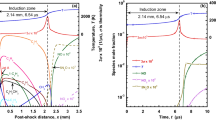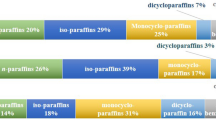Abstract
The use of conventional jet fuels in detonation-based engines is emerging as a promising possibility due to the risks associated with the use of hydrogen as a fuel for commercial aviation. The development of liquid-fueled detonation engines heavily depends on the basic understanding of the detonation chemistry and the combustion behavior of these real fuels in a detonating environment. The current work presents a systematic study of the detonating behavior of two real fuels. The fuels studied are Jet A, a conventional jet fuel used in the aviation industry, and a synthetically developed bio-derived jet fuel, C1. 1D ZND computations are used to compute the relevant detonation properties. The high-temperature chemistry of Jet A and C1 is modeled using a HyChem chemical kinetics model. The detonation chemistry of real distillate fuels was investigated in this study numerically, where relevant chemical length and time scales were calculated and compared. The critical detonation parameters were also evaluated and compared over a range of initial conditions and equivalence ratios. The detonability limits of real distillate fuels were investigated for their application in detonation-based combustors. The fuel–air–diluent mixtures were also studied in the present work, with argon and helium as inert diluents. The ZND computations show that the induction length scale for Jet A–air detonations is nearly half when compared to that of C1–air detonations which can be attributed to the detonation chemistry of the two fuels considered here. The major difference between the detonation chemistry of Jet A and C1 is a result of the composition of major pyrolysis products. The major decomposition product for Jet A is ethylene (C2H4); whereas, for C1, it is iso-butene (i-C4H8). The larger molecular weight of iso-butene leads to smaller diffusivity which results in larger detonation length and time scales for C1 when compared to Jet A at the same initial conditions. The primary objective of the present study is to show how fuel chemistry plays a crucial role in the detonation phenomenon. The study also highlights the effect of fuel composition and their pyrolysis products on the detonating behavior of real fuels for their application in detonation-based engines.








Similar content being viewed by others
Abbreviations
- Δi :
-
Induction zone length (mm)
- τ i :
-
Induction delay time (µs)
- Δdecom :
-
Decomposition zone length (mm)
- τ decom :
-
Decomposition time (µs)
- Δoxid :
-
Oxidation zone length (mm)
- τ oxid :
-
Oxidation time (µs)
- T VN :
-
Post-shock temperature (K)
- V CJ :
-
Detonation velocity (m/s)
- M CJ :
-
Detonation Mach number (–)
- P CJ :
-
Post-detonation pressure (atm)
- T CJ :
-
Post-detonation temperature (K)
References
ATAG (2011) Beginner’s guide to aviation biofuels. Air Transport Action Group, Geneva
Austin JM, Shepherd JE (2003) Detonations in hydrocarbon fuel blends. Combust Flame 132(1–2):73–90
Browne S, Ziegler J, Shepherd JE (2008) Numerical solution methods for shock and detonation jump conditions. Pasadena, CA: GALCIT Report FM2006 6
Ciccarelli G et al (1994) Detonation cell size measurements and predictions in hydrogen-air-steam mixtures at elevated temperatures. Combust Flame 99(01):212–220
Crane J et al (2018) Isolating the effect of induction length on detonation structure: hydrogen–oxygen detonation promoted by ozone. Combust Flame 200(01):44–52
Dahake A, Singh AV (2021) Numerical study on NOx emissions from a synthetic biofuel for applications in detonation-based combustors. Virtual Event, s.n.
Doring W (1943) On the detonation processes in gases. Ann Phys 43(01):421–436
Gavrikov AI, Efimenko AA, Dorofeev SB (2000) A model for detonation cell size prediction from chemical kinetics. Combust Flame 120(01):19–33
Goodwin DG, Moffat HK, Speth RL (2009) Cantera: an object-oriented software toolkit for chemical kinetics. Caltech, Pasadena
Hishida M, Fujiwara T, Wolanski P (2009) Fundamentals of rotating detonations. Shock Waves 19(01):1–10
Inc. G (2019) Sustainable aviation fuel. Englewood, Colorado: GEVO Inc.
Iyer M, Singh AV (2021) NOx Emissions from Jet A-air Detonations. Virtual Event, s.n.
Iyer MSK, Singh AV (2022) Ignition kinetics of real distillate fuels under detonating conditions. Virtual Event, s.n.
Kailasnath K (2000) Review of propulsion applications of detonation waves. AIAA J 38(09)
Kindracki J (2014) Study of detonation initiation in kerosene–oxidizer mixtures in short tubes. Shock Waves 24(01):603–618
Kindracki J (2015) Experimental research on rotating detonation in liquid fuel–gaseous air mixtures. Aerosp Sci Technol 43(01):445–453
Kumar DS, Ivin K, Singh AV (2021) Sensitizing gaseous detonations for hydrogen/ethylene-air mixtures using ozone and H2O2 as dopants for application in rotating detonation engines. Proc Combust Inst 38(03):3825–3834
Kumar DS, Singh AV (2021) Inhibition of hydrogen–oxygen/air gaseous detonations using CF3I, H2O, and CO2. Fire Saf J 124(01):1–13
Lee JHS (2008) The detonation phenomenon. Cambridge University Press, London
Liu S et al (2021) Experimental study on initiation and propagation behavior of propane/oxygen/nitrogen detonation wave. Fuel 293(01):120487
Ma JZ et al (2020) Recent progress, development trends, and considerationof continuous detonation engines. AIAA J 58(01)
Marcantoni LFG, Tamagno J, Elaskar S (2019) A numerical study on the impact of chemical modeling on simulating methane-air detonations. Fuel 240(01):289–298
Neumann JV (1995) Theory of shock waves. World Scientific Publishing Co, River Edge
Shepherd JE (1986) Chemical kinetics of hydrogen-air-diluent detonations. Prog Astronaut Aeronaut 106(01):263–293
Stamps DW, Tieszen SR (1991) The influence of initial pressure and temperature on hydrogen-air-diluent detonations. Combust Flame 83(01):353–364
Wang H et al (2018a) A physics-based approach to modeling real-fuel combustion chemistry—I. Evidence from experiments, and thermodynamic, chemical kinetic and statistical considerations. Combust Flame 193(01):502–519
Wang K et al (2018b) A physics-based approach to modeling real-fuel combustion chemistry—IV. HyChem modeling of combustion kinetics of a bio-derived jet fuel and its blends with a conventional Jet A. Combust Flame 198(01):477–489
Warimani M et al (2021) Internal flow dynamics and performance of pulse detonation engine with alternative fuels. Energy 237(01):121719
Westbrook CK (1982) Chemical kinetics of hydrocarbon oxidation in gaseous detonations. Combust Flame 46(01):191–210
Westbrook CK, Urtiew PA (1982) Chemical kinetic prediction of critical parameters in gaseous detonations. Proc Combust Inst 19(01):615–623
Wilhite J et al (2016) Investigation of a rotating detonation engine using ethylene-air mixtures. s.l., s.n.
Xu R et al (2018) Physics-based approach to modeling real-fuel combustion chemistry—II. Reaction kinetic models of jet and rocket fuels. Combust Flame 193(01):520–537
Zeldovich YB (1940) On the theory of the propagation of detonation in gaseous systems. J Tech Phys (USSR) 10(01):542–568
Zhao M, Zhang H (2020) Origin and chaotic propagation of multiple rotating detonation waves in hydrogen/air mixtures. Fuel 275(01):117986
Acknowledgements
The authors acknowledge the financial support for this work from the Aeronautics R&D Board, Ministry of Defence, Govt. of India vide Sanction Letter # ARDB/01/1042000M/I.
Author information
Authors and Affiliations
Corresponding author
Additional information
Publisher's Note
Springer Nature remains neutral with regard to jurisdictional claims in published maps and institutional affiliations.
Rights and permissions
About this article
Cite this article
Dahake, A., Singh, A.V. A Comparative Study of the Detonation Chemistry and Critical Detonation Parameters for Jet A and a Bio-derived Jet Fuel. Trans Indian Natl. Acad. Eng. 7, 1179–1192 (2022). https://doi.org/10.1007/s41403-022-00353-z
Received:
Accepted:
Published:
Issue Date:
DOI: https://doi.org/10.1007/s41403-022-00353-z




